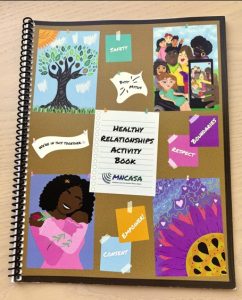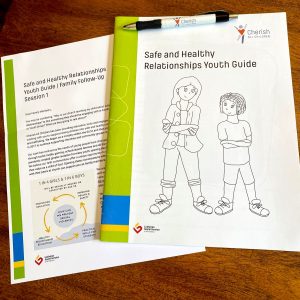Introduction
[1] For many years, I’ve been doing training about safe and healthy relationships in our ELCA churches. Often when I ask, “Who taught you about safe and healthy relationships?” I hear a lot of stammering “…uh…my parents, kinda…my teacher in health class…TV…the internet?” This was my experience as well, although we didn’t have the internet. Those after-school specials filled a gap. I’ve tried to do better as a parent. Yet I understand that we haven’t always been given the tools (or the confidence!) to consistently have meaningful conversations with our children about relationships.
[2] I have a wonderful memory of one such conversation with my children. When sharing a girl’s body book with my daughter, she got up and did a little dance along with her own song, “I love my body, I love my body!” So, it was easy for me to proceed with the book and open discussion. She’s now a young adult, and I can recall many conversations about relationships and sexuality that came about from tv shows we watched together, the pressures of social media, and the dress code imposed in middle school.
[3] Conversation with my son, on the other hand, was more difficult. I remember once, when the conversation started about where babies come from, that he looked over to the Christmas tree and said, “Uh, what’s your favorite ornament?” Our conversations as he grew up were not as frequent as with my daughter. But I tried my best to use life moments to teach about healthy relationships. I’d share my thoughts around how women and girls were portrayed in sports, tv, movies, and online games. I’d ask about incidents that happened at school around relationships, or about high profile cases of abuse or other maltreatment he’d see about famous sports figures.
[4] Most importantly, I didn’t do it alone. Our small congregation had informal male mentors that would engage with my son along with the other middle school and high school boys on Sunday mornings. We moms would gather to talk through challenges of raising middle school kids, like mean girl issues, what to do about phones and social media, and how to instill value beyond looks and online “likes.” Sunday school, Confirmation classes, retreats and Bible camps were all high priority. Our pastor ended Confirmation class in a circle with each youth making the sign of the cross on their neighbor’s forehead with the words, “Remember, you are a child of God.”
Our Call to Our Children
[5] In the creation story, God proclaims that all human beings are made in the image of God. Therefore, all children are made in God’s image and we are called to treat them with dignity and respect, honoring their human equality and intrinsic value. Children are also inherently vulnerable, and we have a responsibility to provide protection, care, and safety. Our Christian tradition calls us to care for and nurture children into the Christian faith and into relationship with one another.
[6] Nurturing right relationships and leading by example are part of the call of rostered ministers: “Will you pray for God’s people, nourish them with the Word and sacraments, and lead them by your own example in faithful service and holy living?” “I will, and I ask God to help me.”1
[7] Parents and Baptismal sponsors are asked: “As you bring your child to receive the gift of Baptism, do you promise to help your child grow into the Christian faith?” “I do and I ask God to help and guide me.”2 We make these promises in front of the entire congregation, inviting them to join us in welcoming, loving, and supporting all children. These relationships are sacred; they are to be honored and cherished. We have been given a gift from God, and we have been given a responsibility to raise children into safe, healthy and equal relationships.
[8] Luther and the early Reformers emphasized the importance of education and protection for all children, asserting, “If we want capable and qualified people for both the civil and the spiritual realms, we really must spare no effort, time, and expense in teaching and educating our children to serve God and the world.”3
[9] While this ideal of sparing no effort, time, and expense is admirable, the reality is that when it comes to relationship education, individual homes and schools may be covering some topics, but too often very little is shared, and youth seek out information themselves through the internet. Some online content can be very helpful and supportive, while other content can be incorrect, misleading, harmful and even dangerous to youth searching on their own. Instead, given some tools, we can offer learning and open communication in our homes and faith communities to connect with youth in a safe space while reinforcing their value as a child of God.
Resources for families and faith communities
[10] Minnesota Coalition Against Sexual Assault (MNCASA) is a statewide coalition with a mission to drive transformative culture change to address sexual violence through advocacy, prevention, racial justice, and systems change. Their vision is a world free of sexual violence in which all human beings are treated with dignity and respect and communities are transformed through safety, healing, and partnerships.4 Many states have similar coalitions that you can find with an internet search.
[11] One of the resources MNCASA provides is a Healthy Relationships Activity Book. This includes an educational and engaging booklet for youth along with a parent/guardian guide to equip them to facilitate these conversations and activities with their youth. Tips for starting conversations are included, such as:
- Keep it short. Brief and frequent conversations are more effective than one big talk.

- Make it positive.
- Brush up on your healthy relationship skills.
- Prepare for difficult conversations. Many resources are provided!
- Focus on togetherness.
- Empower your youth.
- Make it your own!
- Take inventory. Explore your own strengths and values and identify who can support you.
[12] The booklet is designed in four parts, and each part can also be broken down into multiple conversations. Part one focuses on identifying healthy relationships. Red flags, unhealthy relationships, and personal boundaries are also covered, including boundaries with parents/guardians, friends, adults, and partners. While some of these conversations may bring up difficult situations the youth has experienced, opening these conversations provides the opportunity to offer support and build trust.
[13] Part two explores “What is Consent?” Everyday examples of consent are provided along with scenarios to discuss together. Consent is presented as a key and foundational component for all healthy relationships. The scenarios range from asking a friend or partner’s permission if you want to post photos of them online to how to say no to sexual advances in a dating relationship.
[14] The third part of the book delves into gender stereotypes and social norms. These stereotypes can pressure youth into acting, thinking, and expressing themselves in ways that place limits on who they really are, or that are harmful towards others. Parents and youth can work through activities together such as gender box brainstorming “Act Like a Man” and “Act like a Lady.” Discussing the ways our society “expects” people to act and then challenging these stereotypes and social norms can help youth develop a stronger sense of self and more equitable, healthy relationships. This session includes discrimination due to sexism, homophobia, transphobia, and sexual double standards as well. It closes with an exercise “Creating Who I Want to Be.” Taking this time as a parent/caregiver to help your child process through all the pressures of society, peers, social media, and more, will support youth in developing their personal and relational identities.
[15] The final topic focuses on trust and support. The importance of trustworthy and supportive adults in a youth’s life is a significant factor in their healthy growth and development. Youth learn how to identify a trusted adult, who the trusted adults are in their life, and how to be a supportive friend.
[16] Many helpful resources are provided for each topic, from websites to videos, books, and toolkits. This youth activity book and parent/guardian guide provides excellent material to begin these conversations and share the value of healthy relationships throughout a child’s development.
[17] Cherish All Children is a service within Lutheran Social Service of Minnesota. Their mission is to educate, equip, and engage churches and community groups to prevent child sexual exploitation and trafficking.5 With the focus on primary prevention – stopping harm before it occurs – their vision is to raise generations of young people into safe and healthy relationships. By engaging young people in discussions and activities about relationships, both online and in person, youth can gain lifelong skills that prepare them to make safe and healthy choices.
[18] One of their key resources is the Safe and Healthy Relationships Youth and Leader’s Guides. In session one, youth identify and discuss healthy relationship qualities, unhealthy qualities, red flags in relationships, and talk through the principles of consent. Biblical reflection includes Psalm 139, especially focusing on verse 14: For you created my inmost being; you knit me together in my mother’s womb. I praise you because I am fearfully and wonderfully made; your works are wonderful, I know that full well.6
[19] Open questions for reflection can be used within the class time or are offered in Family Follow-up handouts. This provides parents and caregivers opportunity to continue this education in the home, opening up discussions about relationships on a regular basis, not in just “The Talk.” Families can use these questions at any time, not just as part of a Confirmation class or youth group exercise. The more parents and caregivers develop open, honest, and natural conversations around relationships, the more youth will feel comfortable going to them with questions or concerns throughout their developing years.
- What have you learned from those you look up to about healthy relationships?
- What’s the best example of a healthy relationship that you know? What makes it so good?
- What makes us vulnerable to entering into unhealthy relationships?
- What would our world look like if we intentionally honored each other, simply because of our worth and value as human beings and children of God?
[20] In session two, relationships in the online world are explored. This includes social media, gaming, apps, sending photos, or any other ways of engaging in a relationship using the internet. Recognizing that this is a primary way youth are engaging in relationships, learning and skill building are focused on understanding risks and having youth come up with their own answers to how they could handle different scenarios.
[21] Discussion questions for this session or for parents and caregivers include:
- What are some red flags you can be aware of with someone you meet online?
- Do you know who you would go to if you needed to talk about something uncomfortable or unsafe happening online?
- What impressions and ideas about sexuality do we get from video games, social media and other online content?
[22] Session three leads youth into identifying vulnerabilities in terms of what might make it easier for someone to be taken advantage of, or to be harmed physically or emotionally. Thinking through some of these vulnerabilities allows youth to be aware of how they, a friend, or a classmate could fall into the dangers of someone intending to exploit them. Youth then focus on their support network, identifying 2-3 safe adults in their life and 1-3 safe friends that they can go to and talk about anything difficult that may be going on. They also identify their own strengths and how these can act as a protective barrier to keep them safe in various situations.
[23] The final session of the youth guide provides numerous scenarios that youth might experience at school, at a party, in their church youth group, online, or within a relationship. Offering youth time to engage with each other, share stories, and identify choices they can make for themselves will help them problem-solve for real-life situations. Reflecting on scenarios with children at home is a great way to build their problem-solving skills and help them build confidence to react in a healthy way when faced with a difficult situation. These can be adapted as children grow through the stages of their development. The most important take-away is to continue having conversations, staying open to all the ways they are growing up in a world far different from past generations. Stay engaged, listen, be curious, affirm, set healthy family boundaries, correct when needed, and be present.
[24] Every generation has faced new challenges in raising a child to be safe, to feel cherished, and to understand their value as a unique and beloved child of God. However, I do believe this generation’s challenges are accelerated due to the constant access to media, smartphones, social media, gaming, and many more societal factors currently impacting mental health and overall wellness. Coming together to support young people in their growth and relationships is one way we can meet these challenges and create loving communities as God intended.
Be devoted to one another in love. Honor one another above yourselves.
Romans 12:10
Be completely humble and gentle; be patient bearing with one another in love.
Ephesians 4:2
By this everyone will know that you are my disciples, if you love one another.
John 13:35
1 Ordination to the Ministry of Word and Sacrament (pdf) – ELCA Resources
2 Evangelical Lutheran Worship (Minneapolis: Augsburg Fortress, 2006).
3Martin Luther, The Large Catechism of Dr. Martin Luther, 1529, in The Annotated Luther, Study Edition, ed. Kirsi Stjerna (Minneapolis: Fortress, 2016), 326.
4 https://mncasa.org/
5 https://www.lssmn.org/services/youth/education/cherish-all-children
6 All biblical passages quoted are taken from the New Revised Standard Version (NRSV).


